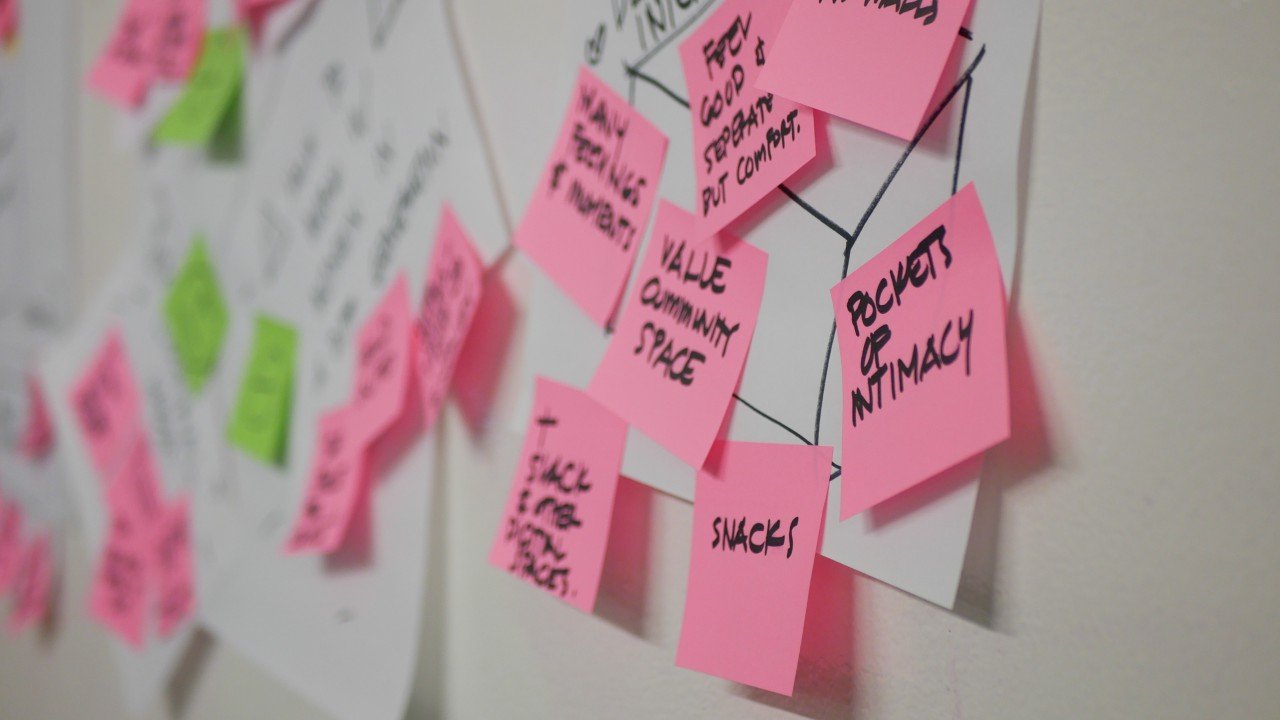What Would Spaces Look Like If Designed from a Feminine Perspective?
This question brought together 50 people at the HUSH offices late last year, when HUSH, in collaboration with the nonprofit Women in Innovation (WIN) , hosted an “unconference” to explore just that. The group gathered to imagine how alternative perspectives—specifically the feminine—might shape the design of space if they were explicitly considered.
It’s a question I’ve carried for a long time, ever since I heard someone say that the standard stair height in architecture was designed around the average North American adult male. While I’ve since come up short verifying that claim (modern standards do include a range of bodies), it cracked open a door of curiosity that’s stayed ajar: For whom is something actually designed? What assumptions, values, or blind spots are embedded in the things we build—simply because of the perspectives prioritized?
This question—or perhaps design intention—is not, by any means, novel. Throughout history, we’ve seen many examples, though it has often focused more on gender and female bodily needs than “feminine” as a perspective. For instance, matrilineal societies designed their communities around maternal lineages - like the Haudenosaunee’s multigenerational longhouses, or the Mosuo’s courtyard-centric homes that center the Yimi (Grandmother’s house). In Biblical times, women had spaces for menstruating, like those depicted in the Red Tent. Spaces like all-girls schools and universities have a long tradition of designing for women. The now-defunct Wing sought to design a communal workplace explicitly for women. Women’s healthcare companies like Tia reimagined the ever-hated annual exam to specifically design a healthcare experience that was designed by and for women.
Against the backdrop of a shifting inclusivity landscape, it’s also important to acknowledge the broader movements that have long asked versions of this same question. The past decade or so, in particular, saw massive shifts in the conversation around inclusive design. For example, digital design leaders like John Maeda helped surface how homogeneous teams can unintentionally encode bias into products and systems, sparking a wave of momentum for more diverse design teams. Scientists like Scott Page empirically proved that diverse groups outperform homogeneous groups when solving complex problems, and cognitive diversity enhances innovation and problem-solving. Because ultimately, when more perspectives are included, design—and innovation—gets better.
Nonetheless, it is a question that is still green with exploration. And so, we convened around it.
As you might expect, the first task was to define what “feminine” even means. Though the term is typically tethered to gender, we approached it as a container: a set of values, qualities, and ways of being. With the transcendence of “feminine” beyond genders, the group (composed of people of all genders and backgrounds) explored what traits and values it may actually contain. We did this by noticing what patterns emerged as we speculated on a reimagining of five typologies of spaces through the lens of the feminine.
Here’s what we discovered—and the questions that lingered.
Designing for Humans > Capital
Across nearly every conversation, participants articulated a desire to shift away from design motivated purely by consistency, efficiency, productivity, and profit—values that have historically shaped spaces through the lenses of capitalism and patriarchy. Instead of designing for how a market acts; designing for how humans act.
In the breakout conversation focused around workplaces, participants imagined environments that acknowledged the real rhythms of the day—the hormonal shifts, snack cravings, moments of overstimulation, the need for retreat. Instead of optimizing for constant output, the vision was of a space that flowed with the body’s cycles, not against them. This approach also surfaced in healthcare and education, where the group expressed exhaustion with having to justify feelings in metrics. That the demand for ROI had flattened out the emotional texture of healing and learning spaces. Designing from the feminine meant restoring the legitimacy of emotional and embodied experience.
There was also a discussion around surfacing design aspects of the market that had been missed—specifically a question of how design could make visible and supported emotional labor and other invisible forms of care.
Designing for Emotional Power
Feminine design means centering emotional intelligence. This kind of design sees care, beauty, and ritual as technologies—ones that generate trust, safety, and cohesion.
Naturally, the group discussing home/housing identified that in many ways the home is one of the few spaces where perhaps a feminine perspective has dominated design. In turn, the home often is a space of freedom, autonomy, expression, ritual.
In the group discussing digital spaces, participants argued that emotional intelligence is the feminine principle with the most untapped potential. Emotional resonance, they argued, isn’t just decorative—it’s functional. It shapes behavior. Designing from the feminine means treating emotion not as noise, but as signal. Could emotional intelligence become a core UX metric? Could empathy be designed into the bones of platforms, not just their overlays?
Designing for Deeper Connection
Another value that emerged was designing for connection—not networking, but intimacy. For the workplace, there were ideas around continuing the trend away from exclusively open floorplans. Instead, creating offices with dynamic floorplans and intentional pockets—spaces designed for moments of rich connection.
In education or healthcare, spaces of deep vulnerability, facilities and operations might be designed to invite opportunities for slowing down and honoring the emotional exposure of healing and learning. Creating systems and places that enable both patients and caregivers, students and teachers, to connect more deeply and create a more positive and lasting impact on health and learning outcomes.
Designing for Ritual
There was a deep recognition that life’s liminal moments—birth, death, illness, transformation–and the spaces that contain these moments of care and transition–labor and delivery units, palliative care rooms–are both inherently feminine, and also overlooked in their design. And, while these rituals feel feminine in nature, the spaces that support them don’t facilitate the feminine values of the experience.
What if those spaces were revered and celebrated instead of minimized? What if the waiting room, the exam table, the birthing suite were designed not for efficiency, but for dignity? One group suggested that the feminine as it influences design might not be about a complete overhaul, but about creating moments and fleeting but meaningful details that stay with you—soft touch points that signal to the body a sense of welcoming.
Designing for Community and the Collective
In all groups there was a strong current of resourcing over individualism. The city planning group mused on a world where design is less about egoistic superlatives—i.e. the tallest building—and more about community and communal well-being. Where cities are planned with community centers at their core, turning homes into nodes of a community web. Where public infrastructure—like transit—was abundant, accessible, and family-centered. In the workplace group, participants considered the idea of “collective KPIs”—success measured not on individual achievement, but collective thriving.
Throughout the breakouts there was a consistent belief: feminine design asks not, "How do we optimize for the highest performer?" but, "How do we support those with the least power?" This isn’t hypothetical. We can look to examples like Switzerland’s “Ticki Park” family coaches on trains, or Japan’s women-only subway cars—small, culturally embedded design decisions that prioritize bodily safety and dignity for those often excluded.
A Prerequisite of Safety
And underlying every discussion was the topic of safety. Feminine design cannot thrive where bodies don’t feel secure. In cities, safety influences whether someone can linger in a third space, walk instead of drive, gather instead of isolate. In healthcare, emotional safety is a precursor to healing. In schools, psychological safety is essential to learning.
Cars, ironically, came up not as symbols of autonomy but as tools of refuge—offering privacy and control in environments that might otherwise feel threatening. Regardless, until cultures can offer a sense of bodily safety for everyone, the promise of feminine-informed design is limited.
While no blueprints were drawn that day, and in fact more questions than answers emerged, something important was outlined. The seeds of a lens, a language, a set of questions that incite a moment of friction that any designer—of spaces, systems, or products—can carry forward into their process. A pause taken when creating to consider the implicit perspectives being designed for, and curiously exploring a wider viewpoint.
As you may have gathered, to design from a feminine perspective isn’t gendered. And, at least for this group, it doesn’t mean coating spaces in pastels or making them smaller, gentler, or more “beautiful” in the stereotypical sense. It is to orient them around values that have long been marginalized in modern design culture: care, interdependence, emotional fluency, adaptability. Spaces that are inviting rather than imposing. Harmonious rather than hierarchical. Spaces layered with meaning, often ephemeral, sometimes ritualistic.Perhaps feminine-informed spaces aren’t about flipping the power dynamic but about dissolving it—making space for many kinds of power to exist together.

